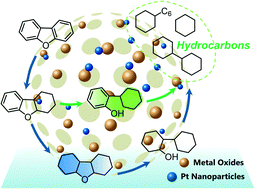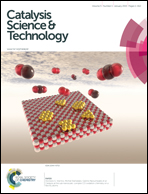Hydrodeoxygenation of dibenzofuran over SiO2, Al2O3/SiO2 and ZrO2/SiO2 supported Pt catalysts
Abstract
The surface of silica with mesopores (SiO2) was post-modified by the deposition of highly dispersed Al2O3 or ZrO2 oxides. Loading of Pt on the modified silica supports yielded higher metal dispersion with respect to the parent silica based on the CO chemisorption and transmission electron microscopy results. Hydrodeoxygenation (HDO) of dibenzofuran (DBF) over the as-prepared Pt catalysts mainly proceeds via the hydrogenation of the aromatic rings, which is followed by the cleavage of the C–O bond to produce oxygen-free hydrocarbons. Preferable hydrogenation of the aromatic rings is observed over the smaller Pt nanoparticles. The relatively strong acidic properties of Al2O3/SiO2 or ZrO2/SiO2, revealed by the NH3-TPD profiles, promote the selective C–O bond cleavage of hexahydrodibenzofuran to alter the HDO reaction pathway. The small sized Pt nanoparticles supported on the Al2O3 or ZrO2 modified silica supports show superior HDO performance with enhanced deoxygenation ability to those over unmodified silica. According to the pseudo-first-order kinetics analysis, the fitted HDO rate constant follows the order: Pt/Al2O3/SiO2 > Pt/ZrO2/SiO2 > Pt/SiO2 under a constant temperature, which is attributed to the cooperative function of the dispersed metal particles and the acidic sites of supports.


 Please wait while we load your content...
Please wait while we load your content...